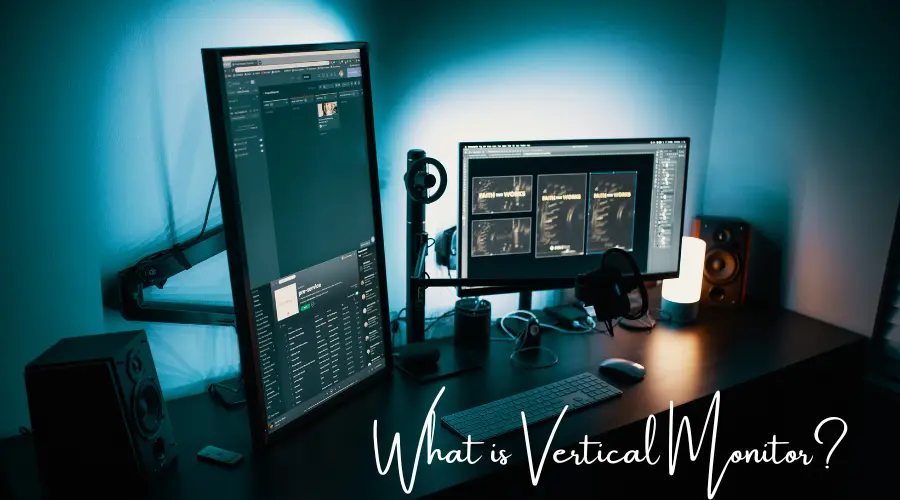Vertical monitors are becoming increasingly popular and for good reason.
They offer a number of advantages over traditional horizontal monitors and can be a great addition to any workspace.
In this post, I will discuss what vertical monitors are, their pros and cons, compare them with horizontal monitors, and more.

Let’s get started!
What is a Vertical Monitor?
A vertical monitor is a type of computer monitor that is taller than it is wide. They are typically used in settings where space is limited, such as in an office cubicle. Vertical monitors have a smaller footprint than traditional monitors, making them ideal for use in small spaces.
This differs from the more common widescreen monitors which are wider than they are tall.
It is great if you are planning to have a multiple monitor setup in your workspace.
A vertical monitor is a great choice when working with many windows such as email, documents, and internet browser windows.
They are also perfect for graphic artists, animators, coders, and other professionals that work with many applications at once.
Vertical monitors are most suited to a single application at a time.
If you are working in Word, Internet Explorer, and Excel in three separate windows you will probably find it easier to see them on a widescreen monitor.
What are vertical monitors ideal for?
Vertical monitors are ideal for a number of different types of work.
Here are a few examples:
Coding:
If you’re a coder, you know that having plenty of screen real estate is crucial.
A vertical monitor gives you a wider field of view, so you can see more of your code at once.
This can be a big help when you’re working on complex projects.
Data Entry:
If you do a lot of data entry, a vertical monitor can help reduce the amount of time you spend scrolling up and down.
Content Writing
If you’re a content writer, a vertical monitor can help you stay focused on your work.
When you have a lot of text on the screen, it can be easy to get lost in your thoughts. But with a vertical monitor, you can see more of your content at once, which can help you stay on track.
For Day Traders:
Day traders can have the trading platform open on one screen while watching a live feed of their stocks, and keeping up with charts.
They set up a multi-monitor setup with a vertical monitor display.
Pros of Vertical Monitor
Here are 4 good reasons why it’s a beneficial investment to buy a vertical monitor:
- Vertical Monitor gives you an extra workspace for doing more work
- They give you a better viewing experience
- A vertical Monitor can help reduce neck and eye strain
- The vertical monitor is very good for some jobs such as coding because it looks at how you would normally read a screen.
Cons of Vertical Monitor
Some cons are:
- Vertical monitors’ aspect ratio is not good for media consumption.
- Vertical Monitors often require additional horizontal monitors for better workflow.
Are Vertical Monitors Better than Horizontal Monitors?
There is a lot of debate surrounding whether vertical monitors are better than horizontal ones to choose as a computer screens.
Some people swear by them, believing that they offer a more immersive experience and improved viewing angles.
Others find that they can’t get used to the vertical layout and find it difficult to use effectively.
Vertical monitors have some clear advantages over horizontal ones. They take up less space, which is especially useful if you have a small desk or limited desktop real estate.
It works exceptionally well for long-form content viewing which requires more vertical space like a long blog or a big chunk of code.
However, there are also some disadvantages to using vertical monitors. They can be confusing to use at first, as most people are used to working with horizontal screens.
Additionally, many applications and websites are not designed for vertical screens, which can lead to usability issues.
There are many tasks like media consumption and video editing which are better done on a horizontal monitor.
You can also use a vertical monitor as a secondary monitor in your workflow.
Can Any monitor be a Vertical Monitor?
Yes, most of the monitors can be set up as vertical monitors. Either they have rotation support with them or you would need an external monitor stand to rotate them.
Many people think that only certain monitors can be rotated to a vertical position, but this isn’t true.
There are a few things to consider before making your monitor vertical. First, think about why you want to do this.
Do you want to save desk space? Do you want to reduce neck strain? Or do you simply prefer the look of a vertical monitor?
Once you know why you want a vertical monitor, it’s time to choose the right stand or mount.
There are many different options available, so take your time and find one that fits your needs.
Most stands and mounts will allow you to adjust the angle of your monitor, so you can find the perfect position for your viewing comfort.
Why do people put their second monitor vertically?
When it comes to having two monitors, people tend to put their second monitor vertically for a variety of reasons.
For some, it’s simply more ergonomic and comfortable to look at a screen that way.
Others find that it helps them stay more organized since they can have different programs open on each screen without having to constantly alt-tab between them.
Still, others simply prefer the aesthetic of a vertical monitor setup.
Whatever the reason, there’s no doubt that putting your second monitor vertically can be a great way to boost your productivity and improve your workflow.
Is a Vertical Monitor better for programming?
Vertical Monitors are better for programming as it gives a bigger area vertically to view more code at once without having to scroll.
In coding, generally, the files are very much longer and you need to scroll up all the time.
With a vertical monitor, you will be able to improve your coding experience.
Can I use a TV as a vertical monitor?
Yes, you can use a TV as a vertical monitor. You will need to purchase a stand or mount to hold the TV in place.
The best way to do this is to measure the width and height of your TV. Then, find a stand or mount that is designed for that size range.
Some people might think that using a TV as a vertical monitor would be difficult because of the different dimensions, but it really isn’t.
You just have to make sure that you get the correct stand or mount. Once you have that, it’s actually very easy to set up and use.
Conclusion
Let’s conclude the post on vertical monitors!
So, if you are looking for a monitor that can help you be more productive, a vertical monitor is a great option!
Now, what’s next?
If you don’t have a vertical monitor already, then you can check this post on the best vertical monitor written by me.
If you already bought one and looking for setup steps, you can check this post on Vertical monitor setup.
I hope you enjoyed reading the post.

I’m Anirban Saha, Founder & Editor of TechBullish. With a B.Tech in Electronics and Communication Engineering, and 6+ years of experience as a software developer, I have expertise in electronics, software development, gadgets, and computer peripherals. I love sharing my knowledge through informational articles, how-to guides, and troubleshooting tips for Peripherals, Smart TVs, Streaming Solutions, and more here. Check Anirban’s Crunchbase Profile here.
